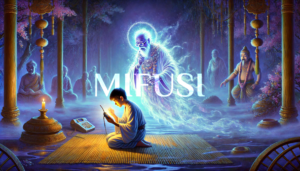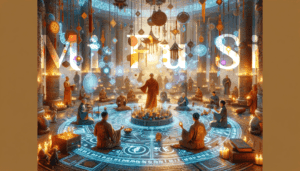Tummo-kundalini practice
(LUYỆN LỬA TAM MUỘI – KUNDALINI)
– sent by Echo on Jan, 14 2009, 03:19, Translated by Dian. edited by rain9811 and xiaobaiyun
The art of generating heat within one’s own body is known by different names across cultures. In Tibet, it’s referred to as Tummo, while in India, it’s known as Kundalini, often associated with the spiral or snake fire. Similarly, in China, it’s called Jing. This mystical ability has been promoted by Tibetan yogis, particularly within the White robe of the Kagyupa sect, famously exemplified by Milarepa.
An illustrative anecdote featuring Rechung goes as follows: Rechung, one of Milarepa’s remarkable disciples, resided with him in a secluded cave. With a belief in the significance of outward appearances, Rechung once encouraged Milarepa to seek out a grand temple befitting his esteemed status. However, Milarepa responded by expressing that his humble moss-covered cave held no less value to him than any adorned temple of jade. Subsequently, Rechung departed from his cave retreat and embarked on a journey across the country to disseminate his teachings. His eloquence and oratorical prowess garnered him widespread renown. In a neighboring region, a prince was so impressed that he constructed a splendid palace for Rechung and even offered his daughter’s hand in marriage. However, the princess, with her arrogance and disdain for Rechung’s humble origins, proved to be a formidable challenge. She went as far as burning his books, driving away his friends, forbidding him from preaching, and pressuring him to prioritize wealth accumulation.
One day, the princess attacked Rechung with a sword, forcing him to flee, wounded. As he ran, he noticed blood stains on his shirt. Surprisingly, the blood was white, a result of his previous Tummo practice. This reminded him of his spiritual path, prompting him to return to Milarepa’s cave and continue his Dharma cultivation there. Eventually, he became Milarepa’s primary disciple and authored “The Life of Milarepa.”
Tummo practice was also documented by Alexandra David-Néel (1868-1969), a mystic and occultist. She described how the sect engaged in Tummo practice contests, where disciples would sit naked by a river on extremely cold nights. A person would dip a blanket into the river and cover each disciple in turn. As the wet blanket froze, the disciple had to use Tummo meditation to generate body heat and dry the blanket. This process continued throughout the night, with disciples drying one blanket after another until dawn. David-Néel heard of instances where someone dried up to 40 blankets using this method. In the isolated forests where these yogis resided, nudity was not a concern. However, during the English occupation of Tibet, many naked yogis were arrested and jailed for perceived offenses against public morality.
At the Samye monastery, there was an elder monk who had achieved mastery in Tummo practice. David-Néel approached him, pleading for instruction. Despite her persistent requests and hints indicating her skepticism towards the mystical powers of mantras or Dharma initiation, the monk eventually relented. He orally transmitted a brief mantra to her and instructed her to ascend the mountain, bathe in the spring there, and then recite the mantra.
Despite it being summer, the mountain’s altitude of 6000 meters made for chilly conditions.She ascended the mountain and submerged herself in the icy water, then settled into meditation, concentrating on chanting the mantra. Over time, her body began to warm gradually, and she experienced a comforting sensation of warmth enveloping her entire being. Despite immersing herself in the cold water and sitting outdoors throughout the night, she did not succumb to the chill or catch a cold. This marked her initial encounter with Tummo practice, despite having not undergone any formal initiation and lacking knowledge of inner energy practices.
After eight years had passed, one day while walking on the mountain slope, she stumbled and fell into the river. The freezing water quickly numbed her legs, leaving her unable to stand as her wet clothes froze around her. Struggling to the river bank, she found herself immobilized on the roadside, realizing that prolonged exposure might lead to freezing to death within the next half-hour. Desperate, she wished she knew the Inner Fire practice and prayed to the Patriarchs for salvation. In her distress, she recalled the mantra, which she hadn’t recited in a long time. Gasping for breath, she struggled through reciting the mantra. Gradually, she felt her body warming, a comforting warmth spreading throughout her being. Within a short time, her clothes dried, and she regained the strength to walk back to the village.
Reflecting on this experience, she recognized it as her second encounter with Tummo, realizing that complex breathing techniques were merely superficial skills. She concluded that it was the power of the Patriarchs that had come to her aid when she chanted the mantra. To her, the mantra itself emerged as the true and singularly significant element in Tummo practice.
Commentary:
During winter atop Snow Mountain, Tibetan priests would sit in meditation, often covered only by a thin robe or naked from the waist up, yet they remained unfrozen, having mastered Tummo or Inner Fire practice.
This practice encompasses various breathing techniques tailored to different proficiency levels. The practitioner assumes a straight posture in a lotus or half-lotus position, with eyes closed, and focuses on slow, deliberate breathing while reciting a mantra. The objective is to guide the breath into the seven ‘chakras’, energy points along the spine, beginning from the last vertebra and ascending to the crown of the head.
In theory, during the breathing practice, one inhales negativity such as sins, greed, anger, and ignorance, and exhales positivity in the form of compassion, forgiveness, non-self, and virtuous charity.
When executed correctly, this breathing technique stimulates the energy points along the spine, eliciting pleasant and sometimes exhilarating sensations. The practitioner may feel as if enveloped in celestial garments or immersed in a fairy realm state. At an advanced stage, successfully directing the energy to ascend to the crown of the head is termed achieving Samadhi, a deep trance state. With Samadhi come extraordinary powers and enlightenment.
This practice necessitates the guidance of an expert guru due to its inherent danger; even a minor mistake can lead to insanity or death. Following the initial stage of breathing practice, the disciple typically undergoes initiation into the Dharma. However, in reality, the guru’s instructions on esoteric practices are often ambiguous and challenging to grasp, leaving the disciples uncertain about their actions. The authenticity of this secretive practice is challenging to verify as it has been embellished with myths and fables.
At the present time, Tibetan monks continue to go up snowy mountains to perform the power of resisting the cold. Likewise, mystic practitioners in Vietnam, Thailand, Laos, and Cambodia often perform magical power of making their body immune to knives stabbing.
In contemporary times, Tibetan monks continue their tradition of ascending snowy mountains to demonstrate their ability to endure extreme cold. Similarly, mystic practitioners in Vietnam, Thailand, Laos, and Cambodia often exhibit the magical power of rendering their bodies immune to knife stabs.
The underlying purpose of all these magical feats is to showcase the power of the gods. However, when comparing the practicality and usefulness of generating heat to resist extreme cold versus withstanding knife cuts, the latter appears to be more applicable. Tummo practice, though intriguing, is inherently difficult, dangerous, and impractical.
In regions with cold climates, individuals have alternative methods to combat frigid weather, such as utilizing warm clothing or carrying extra blankets, water, and food in case of unexpected snowstorms during travel. Why bother with the complexities and dangers of Tummo practice when staying warm can be achieved so easily?
Ms. David-Néel demonstrated remarkable insight and intuition. Following her two experiences with Tummo, she came to realize that despite receiving only the oral transmission of the mantra, she had never practiced any breathing techniques to open her chakras or awaken the Snake Fire. Yet, she was able to generate body heat simply by placing her trust in the mantra bestowed upon her by the Patriarchs. It was through this mantra that they imparted the Inner Fire, ultimately saving her life.
However, David-Néel’s understanding remained incomplete. While she recognized that the Inner Fire could be transmitted solely through the Patriarch’s mantra, bypassing the need for prior breathing techniques in Tummo practice, she continued to attribute miraculous significance to the mantra, thereby overemphasizing its importance.
In this forum, we have demonstrated that individuals can receive and experience the Holy Force from the Buddha, Bodhisattva, and Divinities directly through prayers during the Initiation ceremony, without the need for mantra recitation. We conclude that practices such as quieting the mind, meditation, breathing techniques, visualization, and mantra chanting are merely tools or superficial forms of religious practices that do not necessarily lead to miraculous experiences. The true essence and significant factor behind all miraculous powers or magical feats in religious cultivation lie in the reality of Divinities.
Therefore, religious practitioners need only to seek acknowledgment and protection from the Divinities through spiritual cultivation. Many individuals who have never chanted the Compassion mantra or any other mantra in their lives have, during times of disasters, called upon Kwan Yin, their spirit guardians, or the deities they have an affinity with and have miraculously been saved.
Practitioners of Old_Guru Secret Teaching in the Mystical Universe forum, who have been transmitted the mantra, may choose to chant it as part of their daily devotion ritual. Alternatively, individuals may directly pray to the Spirits they are familiar with or those commonly worshipped in temples. For example, General Luong may pray to Saint Le Van Duyet, as mentioned in Old Guru stories, or Chimdada may pray to the god Nguyen Trung Truc.
When delving into the supernatural or spiritual realm without grasping its true essence, which is to seek Divine blessings through cultivation, practitioners often place excessive emphasis on various meditation techniques, forms, and styles. However, these are merely means to an end, not the ultimate goal of spiritual development. Engaging in certain dangerous techniques such as tummo or kundalini may lead to adverse outcomes, including mental instability, a condition recognized by scientists as the ‘kundalini syndrome.’
It is acceptable to explore certain supernatural practices if they offer health benefits without any harmful side effects. However, it is futile to engage in extremely difficult and perilous practices merely for the sake of showcasing prowess. Any practice involving the physical body will naturally induce physical changes, but these are unrelated to spiritual enlightenment in religious cultivation. Thus, it is erroneous to assert that breathing techniques alone lead to spiritual enlightenment.
True spiritual cultivation involves three essential stages:
1. Self-realization: The earnest pursuit of understanding and assimilating all religious teachings.
2. Assisting others in self-realization: Sharing one’s knowledge and guiding others on the path to enlightenment.
3. Attainment of perfected realization: Gaining wisdom and insight through teaching and practical experience.
Upon reaching the third stage, one is considered to have achieved the Way, qualifying as a Buddha or Teacher of the Dharma. This status brings blessings from Heaven.
(Revised 3/1/2024)
Related Post

Story 10 -Mystical Practice of Invibility
Story 10 -Mystical Practice of Invibility Câu chuyện số 10 - Phép Tàng Hình by ThầyGià on 12 November 2008,...

Chapter VI: V & VI – The Cundi Dharani spoken by the Mother of Seven Kotis Buddhas
V. The Cundi Dharani spoken by the Mother of Seven Kotis Buddhas Tang Dynasty, India, Tripitaka master Amoghavajra translated from...

Heaven’s Plan (By Mysticism Scholar Duc Quy)
Heaven's Plan (By Mysticism Scholar Duc Quy) (Thiên cơ cư sĩ Đức Quý by Lĩnhnam on Oct 15, 2011 11:23...

A grandchild from the future
A grandchild from the future Đứa cháu ở tương lai by kiemmadocco on Dec 05, 2017 at 8:57 pm. Translated...

1 – MYSTICAL TALES AND ITS PRINCIPLES OLD-GURU
1 - The story about Dada the monk (not his true name): Dada is a Vietnamese with Cambodia ancestry, the...

Law of fairness in mysticism
Law of fairness in mysticism (Nguyên tắc công bằng by như-ý on Thu Feb 25, 2010 4:29 pm, translated by...

Rules of H’mong charms and spells
Rules of H'mong charms and spells (Re: Bùa ngãi xứ Mường - QUY TẮC BÙA PHÉP by Thái Hòa on...

Chapter V: THE FRUITS OF SPIRITUAL CULTIVATION
I. Auspicious Dreams. O Subahuh! The reciting of the mantra must not be too slow, too fast, too loud or...
